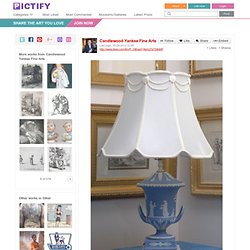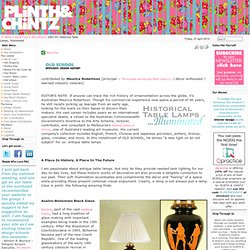

Tilley lamp. Tilley storm lantern X246B May 1978: this model has been in production since 1964.

Operation of a Tilley lamp (Video) The Tilley lamp derives from John Tilley’s invention of the hydro-pneumatic blowpipe in 1813 in England. W.H.Tilley were manufacturing pressure lamps at their works in Stoke Newington in 1818, and Shoreditch, in the 1830s. The company moved to Brent Street in Hendon in 1915 during World War I, and started work with paraffin (kerosene) as a fuel for the lamps. During World War II Tilley lamps were used by the British armed forces, and became so popular that Tilley became used as a generic name for kerosene lamp in many parts of the world, in much the same way as Hoover is used for vacuum cleaners.
Vintage Wedgwood Jasper Lamp. Pair of Wedgwood Jasper Blue Large Champagna Urn Lamps. Pair of Wedgwood Jasper Blue Large Champagna Urn Lamp Wedgwood, strictly Josiah Wedgwood and Sons, is a British pottery firm, originally founded in 1759 by Josiah Wedgwood, which in 1987 merged with Waterford Crystal, creating Waterford Wedgwood, the Ireland-based luxury brands group.

The company still exists as a subsidiary within the group, with its own board of directors and management team. Wedgwood is also used as a general term to describe the company’s main products. The Family and Company History Josiah Wedgwood worked with an established potter, Thomas Whieldon, until 1759, when relatives leased him the Ivy House in Burslem to allow him to start his own pottery business. In 1765, Wedgwood created a new earthenware form which impressed the then English Queen, who gave permission to call it “Queen’s Ware”; this new form sold extremely well across Europe.
A word or two must be said on the designs on Jasper Ware. Wedgwood Jasper Ware "Wedgwood Blue Campagna Urn" Wedgwood “Wedgwood Blue Campagna Urn” Here we have a lovely 20th century Wedgwood Jasperware Urn with applied jasperware relief of Arcadia Scenes.

The work is 12 inches tall and in less than perfect condition (small flaw on the rim of the base, NOT noticeable when displayed. However this is a very lovely and impressive work, very decorative and a great example of the classical. Stamped “Wedgwood” and “MADE IN ENGLAND”. Art, Antiques and Appraisals. A massive Early 18th Century English School Portrait of a velvet-robed English Gentleman, c. 1730.This finely painted oil on canvas is unsigned, a common practice in the day, however it does bear a small, aged paper label on the reverse, as pictured.

The label reads: ”Thomas Hudson, b 1701-d 1779, Master of (Painter?) Joshua Reynolds.” Thomas Hudson was a renowned English Portrait Painter in the mid-1700′s, and indeed, Sir Joshua Reynolds, himself a distinguished English Portrait Painter, was actually one of Hudson’s proteges. When we acquired this painting, it was sold as “attributed to” Thomas Hudson. While I have no reason to doubt that Hudson was the artist, nor can I be certain that he was.
All that being said, this painting is both impressive and massive. The Antique & Vintage Table Lamp Co. The Online Interior Design Magazine - 2007/01: Historical Table Lamps Illuminated. ShareThis contributed by Maurice Robertson [principal – The Antique and Vintage Table Lamp Co. / décor enthusiast / learned industry veteran] EDITOR’S NOTE: If anyone can track the rich history of ornamentation across the globe, it’s Australian Maurice Robertson.

Though his commercial experience now spans a period of 40 years, he still recalls picking up teacups from an early age, looking for the mark on their bases to discern their makers. His vast career includes years as an international specialist dealer, a valuer to the Australian Commonwealth Government’s Incentive to the Arts Scheme, lecturer, contributor, and consultant to Melbourne's National Gallery of Victoria, one of Australia’s leading art museums.
A Place In History, A Place In The Future I am passionate about antique table lamps. Austro-Bohemian Black Glass Bohemia, part of the vast Hapsburg Empire, had a long tradition of glass making with important examples being made in the 15th century. English Parian Porcelain. Anglepoise / Design Museum Collection. Anglepoise Lamp (1933) Design Museum Collection Extraordinary Stories about Ordinary Things, 30 January 2013 - Designed by the automotive engineer George Carwardine, the ANGLEPOISE lamp is based on the ability of a new type of spring invented by Carwardine in 1932 to remain in position after being moved in every conceivable direction.

Efficient and energy-saving, the Anglepoise has remained in production ever since. Many inventors produce ingenious ideas because they set themselves a goal – such as improving the performance of a particular product or finding a new means of tackling a problem – and set their sights on achieving it. Yet one of the most successful examples of amateur British invention, the Anglepoise lamp, was invented by accident, as a by-product of an earlier invention. The Anglepoise lamp was designed by George Carwardine (1887-1948), an automotive engineer who owned a factory in Bath which developed vehicle suspension systems.